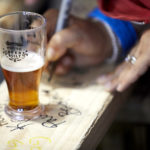December 17, 2017December 19, 2017 “In winter, two things are inevitable: colder temperatures and heartier beers. WHEN THE SUMMER HEAT SETTLES in and the sun blazes, you do what any beer-loving American does: You procure a light, citrusy, cold-as-possible beverage and you drink. And then you drink a couple more. That’s the simple joy of summer beer.
But what happens when the air chills and the snow falls, when the summer seasonals dry up and sessionable beers become unfashionable?
Come winter, phrases like “bourbon barrel aged” and “imperial IPA” and “double stout” along with double-digit alcohol-by-volume levels can make you feel a little intimidated as you take a sip of a 13 percent imperial stout. But winter is the perfect time to savor the complexity, embrace the heaviness and enjoy flavors that come with high alcohol beers — even if they are not your drink of choice.
“There was a trend about four to five years ago that if a beer wasn’t eight percent or higher and sold in a bomber, it didn’t move,” says Shawn Woodbury, head brewer at Maxline Brewing in Fort Collins. “Immediately following that, however, people started to swing the other way, and session beers became the big thing. Ultimately, we just try to have a good mix on offer so if you want high ABV stuff, we’ve got something for you, but our money-range is right around five-and-a-half to six-and-a-half percent.”
However, Woodbury adds, “Fall and winter are bigger times for high ABV beers.”
There are a couple reasons for that. First off, the warmth factor.
“The higher alcohol warms the body,” says Jordan Shipee, Great Divide Brewing’s Fort Collins sales representative. “As you are taking shelter on cold nights, those beers are easy to sit down and warm up with. They are meant to be slow sippers. They help your body acclimate.”
As you are taking shelter on cold nights, those beers are easy to sit down and warm up with. They are meant to be slow sippers. They help your body acclimate.
Great Divide has several beers that are unequivocally big. Their flagship Yeti Imperial Stout as well as their Yeti Clan spin offs weigh in at nine-and-a-half percent ABV, their Hercules Double IPA is 10 percent and their Barrel Aged Old Ruffian, a barley wine-style ale, is 10.2 percent. Want something stronger? Try Great Divide’s Barrel Aged Yeti, a winter seasonal, which hits a whopping 12.5 percent.
Shipee calls high ABV beers “a commitment.” To take on that commitment, he suggests beer drinkers adopt a different mindset: slow down.
“It’s hard to sit on a patio and enjoy a ten percent beer,” he says. “It’s not crushable. The colder months are about sitting down and appreciating a beer over an hour. The flavors in high alcohol beers evolve as they warm up, so it becomes an experience.”
Those flavors are another reason big beers are big in winter. They are often a perfect pair for the season—with cinnamon, nutmeg, caramel, chocolate and coffee common in styles that tend to be high ABV.
“The flavor profiles match with the time of year,” Shippee says. “And my palate can handle them during those months.”
From a brewer’s standpoint, high ABV beers don’t need to smack drinkers in the mouth with booziness. Even when it comes to an 11 percent bourbon barrel-aged Belgian-style dark strong ale.
“The biggest beer we do is Dark Prophet,” says Gordon Schuck, head brewer and co-founder of Funkwerks in Fort Collins. “We tried to make it approachable for something that’s 11 percent alcohol. It’s aged in bourbon barrels, but it’s subtle. We want beers that are drinkable.”
What brewers have learned is that drinkers are not looking for high alcohol beers purely for the sake of having lots of alcohol. In Colorado especially, drinkers have high expectations. They are looking for innovation, complexity and creativity. They want dry hopped sour beers and barrel aging and modern styles and new takes on traditional styles.
“In Colorado, the market demands innovation. As a brewer, it allows you to let your freak flag fly,” Shippee says.
That innovation doesn’t always translate into more alcohol but sometimes it does. The point is, ABV is just a number.
“Ultimately, I’d say don’t focus so much on ABV,” Woodbury says. “Not all high ABV beers are good beers, and not all good beers are high ABV. Depth of flavor can happen at any ABV.”
But if you find a big beer you enjoy, he says, grab your slippers, sit down by the fire and enjoy every sip. “Boozy beer season is short,” he says, “but delicious.”
To read the full article click here.
News Recent Press
Original Source Here

